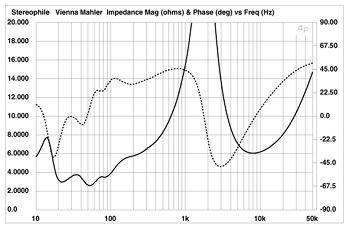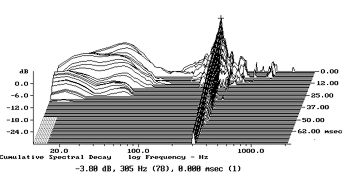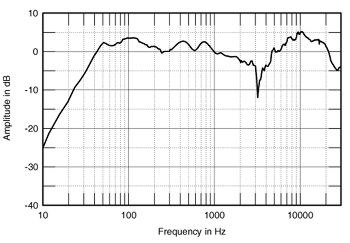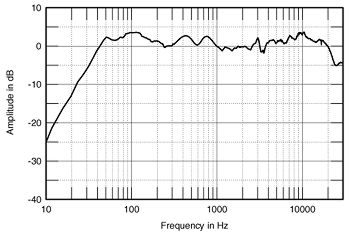| Columns Retired Columns & Blogs |
Vienna Acoustics Mahler loudspeaker Measurements
Sidebar 3: Measurements
I estimated the Mahler's B-weighted sensitivity as 87dB(B)/2.83V/m, which is lower than specified. However, I was measuring on the tweeter axis, and a mid-treble suckout on this axis (see later) will reduce the measured figure. The speaker featured a wide variation in impedance magnitude (fig.1), which will make its perceived balance more dependent than usual on the partnering amplifier's source impedance. More important, the impedance drops below 3 ohms throughout the bass, which will mandate using an amplifier with good current delivery.

Fig.1 Vienna Acoustics Mahler, electrical impedance (solid) and phase (dashed). (2 ohms/vertical div.)
A small wrinkle just above 300Hz is apparent in this graph, which usually indicates the presence of some kind of resonant problem. Fig.2 shows a cumulative spectral-decay plot calculated from the output of a simple accelerometer fastened to the speaker's side wall opposite the woofers and adjacent to the lower midrange unit. A reasonably strong vibrational mode can be seen at 305Hz, which correlates with the anomaly in the impedance measurement. Predicting the subjective effect of this resonance is difficult—I would have expected some slight overhang on male voice, but RD didn't make any comment on this. As is sometimes the case, the measurement looks worse than the reality sounds.

Fig.2 Vienna Acoustics Mahler, cumulative spectral-decay plot calculated from the output of an accelerometer fastened to the cabinet side wall. (MLS driving voltage to speaker, 7.55V; measurement bandwidth, 2kHz.)
Fig.3 shows the Mahler's frequency response, averaged across a 30 degrees angle on the tweeter axis. What would otherwise be quite a flat balance is spoiled by a significant lack of energy in the crossover region between the upper midrange unit and the tweeter. I always take my primary measurement on a speaker's tweeter axis for consistency. However, the Mahler's tweeter is high, some 47" from the floor, and I suspected that the speaker's designer had aimed the primary axis below the tweeter. This is confirmed by fig.4, which shows the Mahler's family of responses in the vertical plane. As long as the listener sits with his or her head level with the midrange units, he or she will perceive a basically flat response (fig.5).

Fig.3 Vienna Acoustics Mahler, anechoic response on tweeter axis at 50", averaged across 30 degrees horizontal window and corrected for microphone response, with the complex sum of the nearfield woofer, port, and midrange responses plotted below 300Hz.

Fig.4 Vienna Acoustics Mahler, vertical response family at 50", from back to front: response 10 degrees-5 degrees above tweeter axis; response on tweeter axis; response 5 degrees-15 degrees below tweeter axis.

Fig.5 Vienna Acoustics Mahler, anechoic response on upper-midrange axis at 50", corrected for microphone response, with the complex sum of the nearfield woofer, port, and midrange responses plotted below 300Hz.
- Log in or register to post comments




































